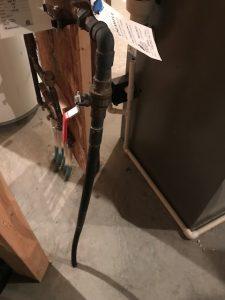This is a quick guide that will explain how to turn off the water in your home in case of an emergency. Water is incredibly damaging, in fact, more homes in North America are damaged by water every year than any other element. 10 to 15 minutes of water being allowed to flow can cause tens of thousands of dollars in damage to your house. The faster you act the better. This is a skill that should be taught to everybody in your household that might be responsible for the safety of the home.
Here is a step-by-step guide to locating and turning off your house’s main water supply valve.
Step number one: Locate the main shut off valve
 In older homes, it’s a good chance that this will be a brass valve with a round handle. Typically the main water is usually very close to the water meter and located near the perimeter of the room at ground level. So if you are in your basement, start by looking at eye level or higher. In my home and in many newer homes the main water line might even come up through the basement floor and have more of a traditional on-off valve. Be sure that you do not confuse your natural gas shut off valve with the water valve. If you have had a home inspection in recent years the main water valve should be marked.
In older homes, it’s a good chance that this will be a brass valve with a round handle. Typically the main water is usually very close to the water meter and located near the perimeter of the room at ground level. So if you are in your basement, start by looking at eye level or higher. In my home and in many newer homes the main water line might even come up through the basement floor and have more of a traditional on-off valve. Be sure that you do not confuse your natural gas shut off valve with the water valve. If you have had a home inspection in recent years the main water valve should be marked.
Step number two: Turn the valve off
Depending on the age of your home might determine the type of valve that you have. If your home is older and has a round handle you will want to turn this clockwise. Once you turn this valve to the off position only water that was already in the pipes will remain. If you are in a flooding situation the water should stop flowing very quickly. You can speed up how quickly the water stops by opening up a faucet in your kitchen or bathroom. if you are in a newer home you may have a simple on-off valve where you simply turn the handle so that it is running horizontally to the water pipe.
Step number three: Watch out for any electrical dangers
 We’ve all been taught the water and electricity don’t mix, if you are in a flooding situation one of the main considerations that you need to have is to turn the electricity off at the main breaker. Any standing water that is close to electrical outlets can create an extreme Danger, always use caution if you are going to turn your power off. Look for any sources of water that might be close to an electrical source. if you do not feel comfortable performing this task, leave it alone and wait for the professionals to arrive. If you deem it is safe to turn the electrical panel off at the breaker then do so.
We’ve all been taught the water and electricity don’t mix, if you are in a flooding situation one of the main considerations that you need to have is to turn the electricity off at the main breaker. Any standing water that is close to electrical outlets can create an extreme Danger, always use caution if you are going to turn your power off. Look for any sources of water that might be close to an electrical source. if you do not feel comfortable performing this task, leave it alone and wait for the professionals to arrive. If you deem it is safe to turn the electrical panel off at the breaker then do so.
Step number four: turn the water back on by turning the valve counter-clockwise
Turning your water back on after any repairs have been made is very easy. you simply need to turn the valve back in a counterclockwise direction or if you have a simple valve turn it so that it is parallel to the water pipe. Remember this step is only to be taken once necessary repairs have been performed.
Step number five: prepare a water emergency plan with your family
As we discussed earlier, water is extremely damaging and dangerous to homeowners. creating a water safety emergency plan with your family is very important, and should include anyone in your household who might be responsible for your own safety.
It doesn’t take a leak very long to cause tens of thousands of dollars in damage, you are going to want to act fast in the event of a water leak. Water leaks can happen from faulty valves, fixtures, faucets or in more serious events of a burst pipe.
Shutting Off The Main Water Supply
You should know how to turn the valves off to a single sink, appliance, or toilet. You need to know where the valves are located and how to turn each individual one off. in more serious situations you will need to know where the water mean is located and how to turn that off as discussed above. Once you have turned off the water main test it by turning on a faucet in your kitchen or bathroom.
This quick little guide can save you thousands of dollars in the event of an emergency. once you have located and turned off the main water valve call Plumbing professional into source the problem area and make the necessary repairs.



